
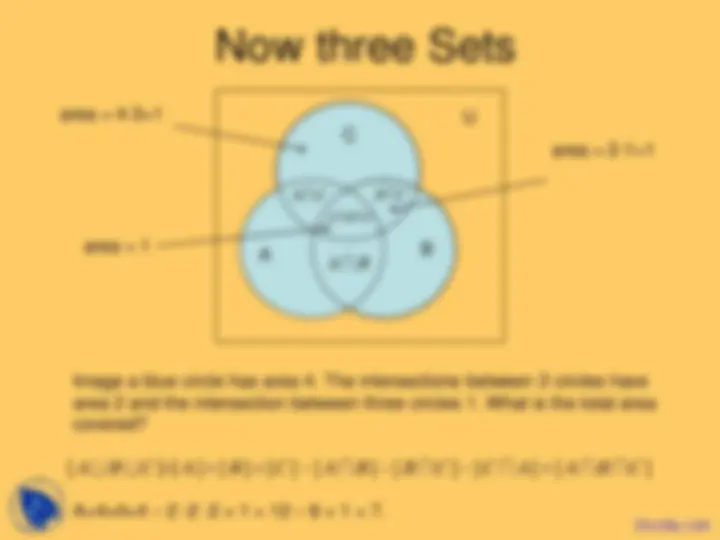
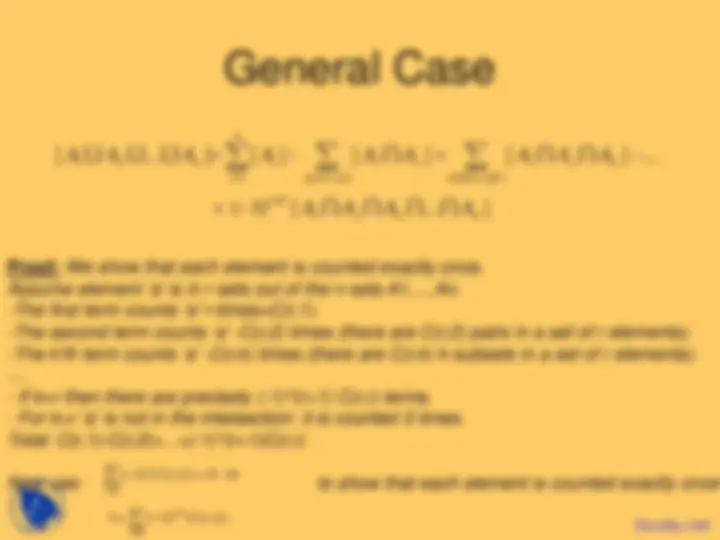
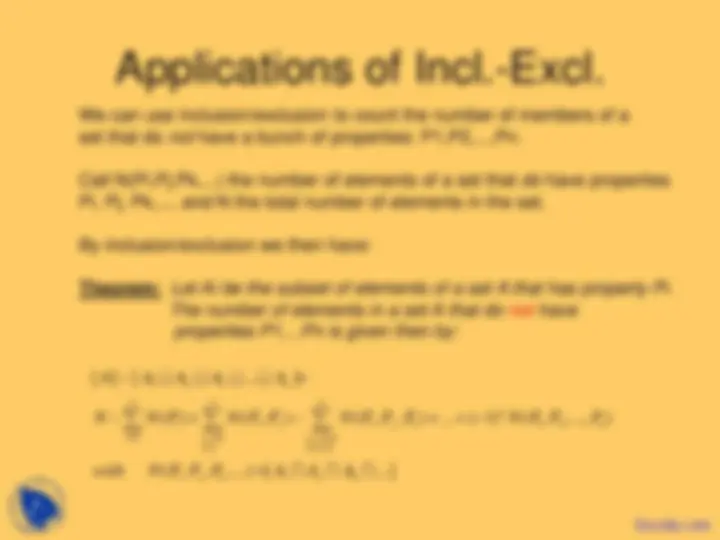
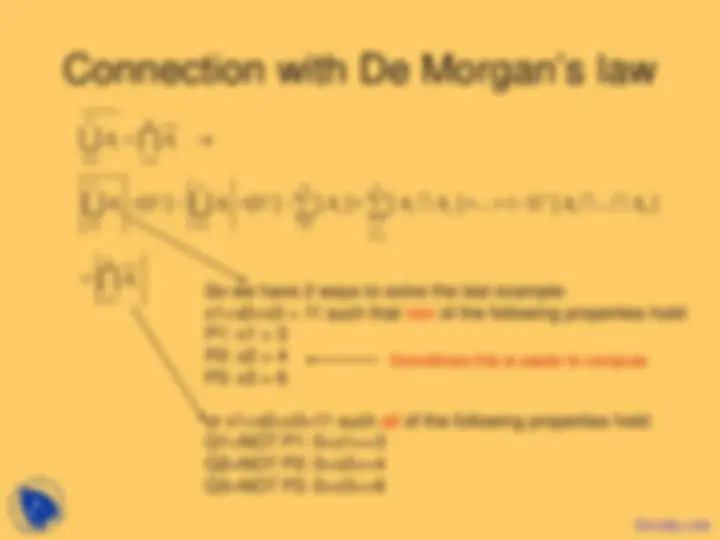
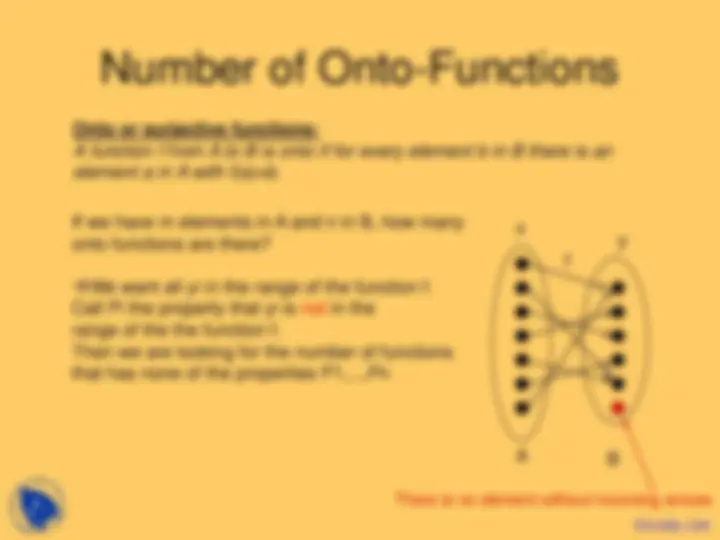
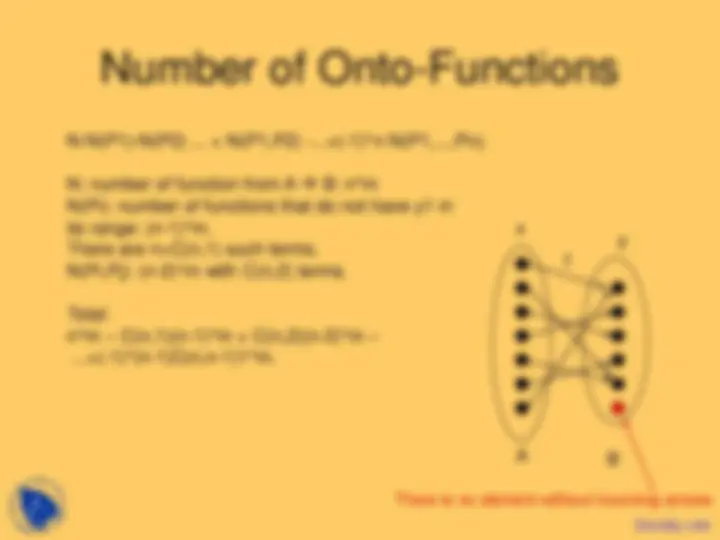
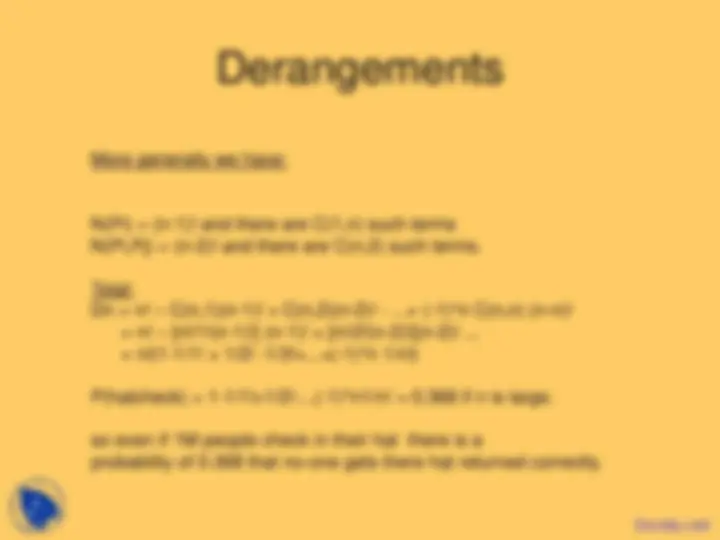



Study with the several resources on Docsity

Earn points by helping other students or get them with a premium plan


Prepare for your exams
Study with the several resources on Docsity

Earn points to download
Earn points by helping other students or get them with a premium plan
Community
Ask the community for help and clear up your study doubts
Discover the best universities in your country according to Docsity users
Free resources
Download our free guides on studying techniques, anxiety management strategies, and thesis advice from Docsity tutors
During the study of discrete mathematics, I found this course very informative and applicable.The main points in these lecture slides are:Inclusion Exclusion, Second Term Counts, Number of Elements, Subset of Elements, Non-Negative Integers, Connection with De Morgan’s Law, Number of Onto-Functions, Surjective Functions, Derangements, Hatcheck Problem
Typology: Slides
1 / 14

This page cannot be seen from the preview
Don't miss anything!









It’s simply a matter of not over-counting the blue area in the intersection.
(^1 21) ( ) ( ) 1
| ... | | | | | | | ... ( 1) | ... |
n n (^) i i (^) pairs ij i j (^) triples ijk i j k n i j k n
A A A A A A A A A A A A A
=
= − + −
Proof: We show that each element is counted exactly once. Assume element ‘a’ is in r sets out of the n sets A1,...,An. -The first term counts ‘a’ r-times=C(r,1). -The second term counts ‘a’ -C(r,2) times (there are C(r,2) pairs in a set of r elements). -The k’th term counts ‘a’ -C(r,k) times (there are C(r,k) k-subsets in a set of r elements). -...
_- If k=r then there are precisely (-1)^(r+1) C(r,r) terms.
Now use: (^) 0 to show that each element is counted exactly once 1 1
( 1) ( , ) 0 1 ( 1) ( , )
r (^) k k r k k
C r k C r k
=
=
− = ⇒ = −
∑ ∑ Docsity.com
We can use inclusion/exclusion to count the number of members of a set that do not have a bunch of properties: P1,P2,...,Pn.
Call N(Pi,Pj,Pk,...) the number of elements of a set that do have properties Pi, Pj, Pk,.... and N the total number of elements in the set.
By inclusion/exclusion we then have:
Theorem: Let Ai be the subset of elements of a set A that has property Pi. The number of elements in a set A that do not have properties P1,...Pn is given then by: 1 2 3 1 , 1 , , 1 1 2
n n n n i i j i j k n n i i ji j i j ki j k i j k i j k
with N P P P A A A
= (^) < = (^) < <=
Compute the number of solutions to x1+x2+x3= where x1,x2,x3 non-negative integers and x1 <=3, x2<=4, x4<=6. P1: x1 > 3 P2: x2 > 4 P3: x3 > 6 The solution must have non of the properties P1,P2,P3. The solution of a problem x1+x2+x3=11 with constraints x1 > 3 is solved as follows:
x1 x2 x
7 more balls 4 balls in basket x already.
Total number of ways: C(7+3-1,7)=
Therefore: N-N(P1)-N(P2)-N(P3)+N(P1,P2)+N(P2,P3)+N(P1,P3)-N(P1,P2,P3) C(11+3-1,11) – C(7+3-1,7) – C(6+3-1,6) ... – 0. Docsity.com
Connection with De Morgan’s law
1 1
1 1 1 ,^1
1
| | | | | | | | ... ( 1) | ... |
n n i i^ i i n n n n (^) n i i^ i i^ i^ i^ i j i^ j^ n i j n i i
A A
A U A U A A A A A
A
= =
= = = <
=
= →
= − = − + + + −
=
∑ ∑ ^ ^
(^) So we have 2 ways to solve the last example: x1+x2+x3 = 11 such that non of the following properties hold: P1: x1 > 3 P2: x2 > 4 P3: x3 > 6 or x1+x2+x3=11 such all of the following properties hold: Q1=NOT P1: 0<x1<= Q2=NOT P2: 0<x2<= Q3=NOT P3: 0<x3<=
Sometimes this is easier to compute.
f
x y
There is no element without incoming arrows
N-N(P1)-N(P2) ... + N(P1,P2) -...+(-1)^n N(P1,...,Pn).
N: number of function from A B: n^m N(Pi): number of functions that do not have y1 in its range: (n-1)^m. There are n=C(n,1) such terms. N(Pi,Pj): (n-2)^m with C(n,2) terms.
Total: n^m – C(n,1)(n-1)^m + C(n,2)(n-2)^m – ...+(-1)^(n-1)C(n,n-1)1^m.
A derangement: is a permutation that leaves non of the elements in its place.
Example: (3,2,1) is not a derangement, but (2,3,1) is one. Then: how many derangements are there of a set of n elements. This is the answer to the Hatcheck problem: If n people check in their hats and the employee randomly returns hats back to people: what is the probability no-one gets their own hat back: P = number of derangements of n / total number of permutations = Dn / n!
More generally we have:
N(Pi) = (n-1)! and there are C(1,n) such terms N(Pi,Pj) = (n-2)! and there are C(n,2) such terms.
Total: Dn = n! – C(n,1)(n-1)! + C(n,2)(n-2)! - ...+ (-1)^n C(n,n) (n-n)! = n! – [n!/1!(n-1)!] (n-1)! + n!/2!(n-2)!! ... = n!(1-1/1! + 1/2! -1/3!+...+(-1)^n 1/n!)
P(hatcheck) = 1-1/1!+1/2!-...(-1)^n1/n! = 0.368 if n is large.
so even if 1M people check in their hat there is a probability of 0.368 that no-one gets there hat returned correctly.
Next time we will do a review of the material you need to know for your final exam.
This will be useful if you want to know what kind of questions to expect and on what topics.
I will also ask you to fill out evaluation forms.